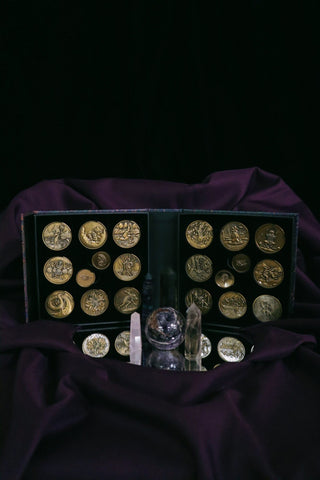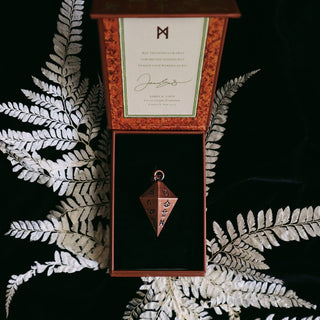GUIDE TO GEOMANCY
INTRO TO GEOMANCY

GEOMANTIC VISIONS
Geomancy is one of the oldest forms of divination, it has been traced back to Arabic texts from the 6th century but it has likely existed much longer. It was widely used in medieval times and has since evolved through the centuries as it gained and lost public attention.
I was taught geomancy by a friend several years ago and I immediately found it fascinating. I wanted to make something that would honor the art of geomancy and add to the craft.
I had the idea to bridge the Cosma Visions Oracle deck with a geomantic set. There was something perfect that allowed the suit of beings to become the 16 figures of geomancy. So late one night the Elementalist became Puella, and the Protector became Puer. The Peacemaker turned into the wise Albus and the Fighter into hot-headed Rubeus. I sat with these beings for a while to make sure they spoke truly to their geomantic counterparts.
It is my hope that the magic and love I poured into these coins can be felt as you hold them in your hands.
May your new adventure open up many doors,
James
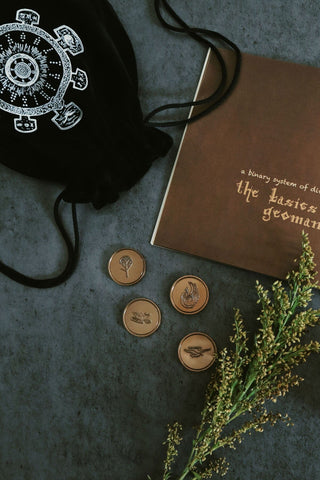
THE BASICS OF GEOMANCY
The difference between tarot and geomancy was first described to me as this: geomancy will help you answer a yes or no question, while tarot will tell you what is happening in your subconscious world. I later learned that this wasn’t quite so much the case, but it did help to understand the idea behind geomancy. What I later came to realize is that geomancy reveals to us the possible outcomes of a quesited situation in the timeline we are currently living in. It assumes that the intertwined fates of this outcome are already in play and that it is the truth of the future. Now, while this does put into question the idea of free will, nothing is unchangeable. If change is desired, then it can be created.
Throughout time, Geomancers have used different methods to divine answers about the future. Geomancers were often consulted for a variety of questions on how to approach future decisions. The name “geomancy” is derived from the Latin “earth magic”. One early method of geomancy was to use a stick to make marks in the dirt or sand. This later developed to a pen and paper. The 16 geomantic coins are here for you as an added system of symbolism to help understand geomancy, but it is important for you to know how to do geomancy in the traditional sense so that you can better understand the roots of the craft.

UNDERSTANDING THE FIGURES
The 16 geomantic figures have remained the same throughout time-the names have been adapted to different languages but the root meaning of each is the same. In this book we will be using the original Latin names. Now, you may be thinking that 16 possibilities do not offer much variation compared to something like tar.ot that has 78 (or 156 with reversals), but each geomantic figure represents many different things. Each figure is associated with an astrological sign, a planet, an elemental structure, the physical attributes of a person and a part of the body. Each of the 16 figures have a full page dedicated to their meanings within this book.
What is interesting about geomancy that is unlike most other forms of divination, is that there is no set ordering to the figures. Some Geomancers prefer to order them based on their elemental make up, others order them based on their planets or astrological signs. Here I have chosen to order them alphabetically for educational purposes.
The geomantic figures represent all of the possible combinations of dots in lines of one or two. For example, you can see that Populus includes all 8 dots, while via contains only 4.
Every figure in between these two contains variations of one or two dots in each line.
Below, the 16 geomantic figures are presented in alphabetical order.

Below is another way to order the figures, which will help with understanding how simplified this form of divination is. Each figure has a counterpart, or an inversion where the opposite formation of dots make up the counterpart:
In the first box we have Acquisitio and Amissio. Acquisi.tio stands for “gain” and Amissio stands for “loss”. You can see that Acquisitio is the opposite formation of Amissio.
In the next box is Rubeus and Albus. Rubeus, or “the red” stands for many dark things and is the opposite of Albus, or “the white” which represents peace and illumination. Rubeus is an unfavorable figure in most cases and can be seen as violent and often chaotic. On the other hand Albus is a fortunate figure of wisdom, but is weak and passive.
The third box contains Carcer and Conjunctio. Carcer stands for “incarceration” and Conjunctio stands for “connection”. These figures are met in balance as they both deal with mobili.ty and growth. Carcer represents being stuck in one place where.as Conjunctio represents where two paths or people meet together.
In the fourth box we find Fortuna Major, or “greater fortune” and Fortuna Minor, or “minor fortune”. Both of these figures deal with success and fortune. Fortuna Minor represents temporary good fortune, but something that over time will not last, whereas Fortuna Major stands for great stable fortune.
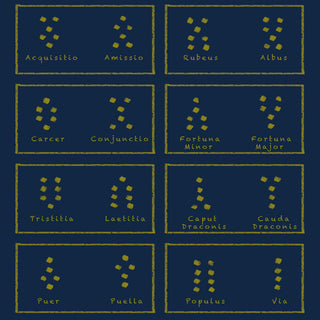
The fifth box contains Tristitia and Laetitia, and speaks towards happiness. Tristitia stands for “sorrow” and Laetitia, a very favorable figure, stands for “joy”.
The sixth box deals with beginnings and endings. Caput Draconis, or “the head of the dragon” represents beginnings while Cauda Draconis, or “the tail of the dragon” represents endings.
In box seven we have Puer and Puella, the balance of sexuality and beauty. Puer, or “the boy” represents male energy and is unbalanced and aggressive. In opposition we have Puella, or “the girl” which represents female energy and harmony.
Finally, in the last box we have Populus and Via. Populus, or “the people” is the most passive figure simply represents a lot of something, whereas Via, or “the way” is the most active figure and represents change and movement forward.
FAVORABLE AND UNFAVORABLE FIGURES
When conducting a geomantic reading, it is important to pose a question that will have an either favorable or unfavorable outcome. In a basic reading that isn’t too complex, you will be able to deduce an outcome based on the favorability of the final figure in the reading.

The 16 figures all have either favorable, neutral or unfavorable aspects. Most of the time these are not concrete, but can change based on the situation at hand, this especially applies to the neutral figures. On the following page you will find the 16 figures reorganized on a scale of favorable to unfavorable. But again, there are variations to this that will make some figures more favorable depending on the question at hand. For example, Amissio, or “loss”, is generally unfavorable. In most situations you are looking for something not hoping to lose it. But, when questions about illness or other situations where loss is desired, this figure becomes favorable. On the other hand, Cauda Draconis is almost always an unfavorable figure except in situations where you are hoping something will end.
The neutral figures are only neutral alone, once they are brought into context and are interacting with other figures their favorability changes.

Conjunctio for example is highly favorable when talking about a contract, deal or union whereas it is highly unfavorable when being stuck with a decision and needing a concrete answer. Via embodies change itself and so its favorable aspect will morph depending on the situation as well. Populus is one figure that is generally always neutral. It adds volume to something and echoes it, but it has no sway and doesn’t offer much in most situations, unless it has to do with the voices of many.
When doing a geomantic reading you will want to structure your question in terms of favorable or unfavorable results. For example, something like “Will I get the promotion at work?” is a much better way to phrase “Should I stay at my current job in hopes of getting a promotion?” Any question that involves the subjects free will to change their mind will come up with a neutral or unclear answer.
STABLE AND UNSTABLE FIGURES
When we are interpreting a geomantic reading we also want to look at the stability of the figures that appear. There are 8 stable and 8 unstable figures in geomancy. Stable figures suggest that something may last or maintain for quite some time, where as an unstable figure suggests that it will be short term or fleeting.
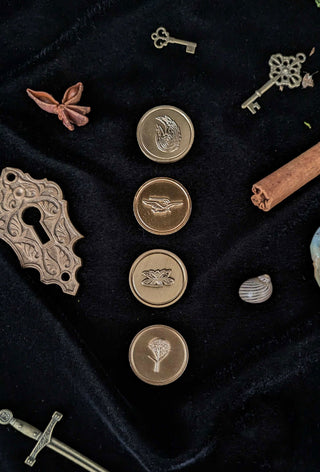
GEOMANCY AND THE ELEMENTS
One of the first things to understand about the make up of the figures is the importance of the elements in geomancy, as it is at the heart of the magic. The combination of dots in the sixteen figures of geomancy represent the 16 possible elemental combinations of Fire, Air, Water and Earth. A geomantic figure is made of four lines, each line is represented by a different element and it always falls the same order.
Each line in the structure of a geomantic figure also represents a part of the body:
Fire is represented by the head,
Air is represented by the neck & throat
Water is represented by the body
Earth is represented by the feet
Each of the sixteen Geomantic figures has a combination of these elements in a passive or active presence. Figures are composed of four lines of dots, each line can have either one or two dots.

If the line has one dot it is considered an active element, if it has two dots it is considered passive. Think of them as two possible slots to fill, if both are filled then there is no where to move, if one is empty then the element can jump between both, making it active.
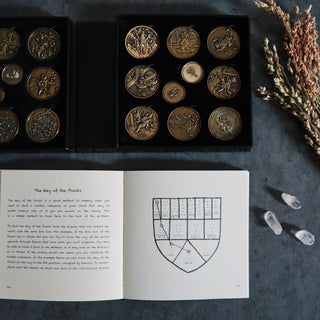
For example, Via is the most active Geomantic Figure, in each line there is only one dot, making all four elements active. Via stands for change. The opposite of this is Populus, which represents “the People”. In Populus, all four elements are passive. Populus is the most passive figure and is essentially just the presence of a lot of something, without much direction or a clear voice, making it very neutral.
What is especially unique with geomancy is that, except for the first four figures in the shield, all of the figures in the shield are created from the ones that came before. It asks the geomancer to focus on the craft and check their work (and math) carefully. Any error will throw the whole chart off. Luckily, there are ways to tell when you’ve made a wrong step and this will be covered later in the section on geomantic shields.
It may all seem a bit confusing now, but as long as you remember that this is only a binary system you will find that geomancy is one of the more simplified forms of divination. The next section breaks down each of the 16 geomantic figures and includes illustrations of each coin as well as the keywords and aspects of each figure.
CASTING A SHIELD
“Casting the Shield” is the terminology in geomancy for the act of beginning a reading. The geomantic shield acts as your chart for each reading. Similar to a spread of tarot cards, each geomantic shield is unique and thorough. From this shield we can make many connections and correlations as well as overarching themes and potential outcomes. There are a total of 15 figures present in a geomantic shield. These figures change depending on your reading, not all of the geomantic figures are present in each shield. Sometimes a figure will repeat multiple times. As you become more familiar with geomancy you will start to notice patterns and even be able to predict what figures will show up further down the shield. Certain combinations of figures will always produce the same results.

